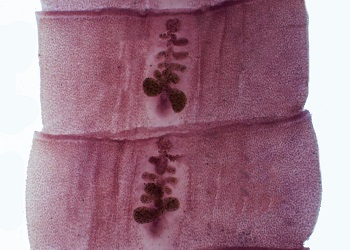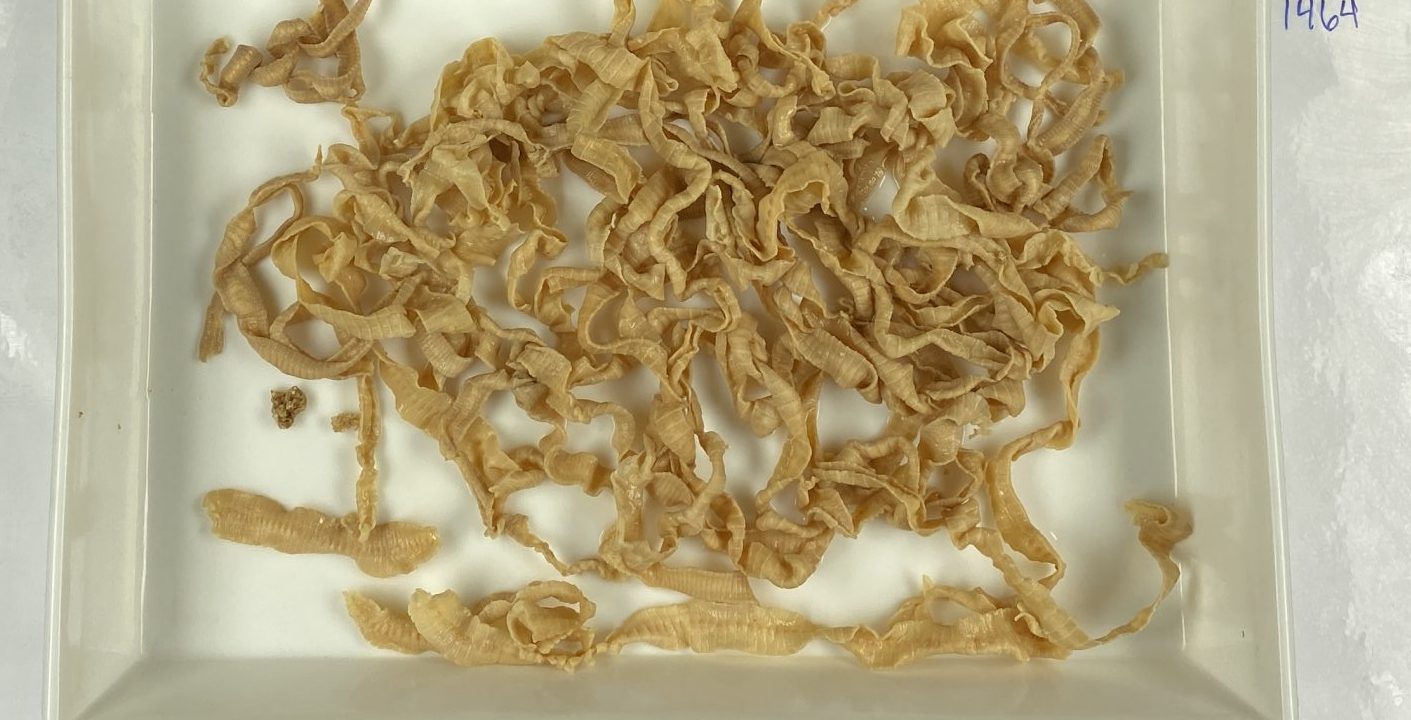Author: Rita Austin (former group member)
Known as broad or fish tapeworms, these spaghetti impersonators are some of the largest parasites that can infect humans. Transmitted to humans via undercooked or raw fish meat, Diphyllobothrium are found in fresh and marine waterways around the world.
Characterized as flatworms, they are also considered pseudophyllidean cestodes, because of the two bothria (grooves) on their heads (scolex), rather than suckers (cyclophyllidean cestodes) that are seen on all other human infecting tapeworms (Figure 1).

I grew up fearful of tapeworms. Not because infections were common or a constant concern, but because of the popularization (dramatization?) of their insidiousness as internal parasites. While my understanding of tapeworms and biology has grown since childhood, tapeworms remain a bit uncanny and creepy. Leaning into dark curiosity and academic intrigue, here are 10 cool facts!
10 cool facts about Diphyllobothrium:
1. A typical length range for human infections is between 4 and 15 meters in length, but have been known to grow up to 25 meters (Durrani and Basit 2022)! All within the human intestinal tract!
2. Like many fashion trends, being sickly skinny has faded in and out of mainstream desires. But people of the Victorian Era may have also employed the so-called ‘tapeworm diet’ to ensure a slight figure by ingesting a capsule of tapeworm eggs to introduce the parasite into their gut. However, there is disagreement about whether live eggs were actually used in the pills or if a placebo was sold instead, or, indeed, if the diet itself was sensationalized myth (see Zarzo et al. 2022); either way, radical diets have permeated history.
3. Diphyllobothrium latum (Dibothriocephalus latus) is generally thought to be the most common species infecting humans and is endemic to circumpolar regions, including Norway. However, infections have been reported worldwide, including in South America, which may be due to global importation and aquaculture practices (DPDx 2022).
4. Linnaeus described the first Diphyllobothrium species, Taenia lata (now called D. latum), in 1758.
5. Growing segments (proglottids; Figure 2) are hermaphroditic and easily shed from the animal upon maturation (containing testes, ovaries, and eggs), releasing infective eggs into the hosts’ feces.

6. The earliest known human infection of Diphyllobothrium (called diphyllobothriosis) is from Peru between 10000-4000 BC (Reinhard 1991, Scholz et al. 2009).
7. Diphyllobothriosis can affect many marine and terrestrial mammals and birds, including porpoises, whales, dogs, gulls, bears, and seals (Scholz et al. 2009).
8. While Diphyllobothrium species are known for their size, infection diagnosis relies on examination of their microscopic eggs in stool samples. However, identification based on eggs often does not allow for species diagnosis. More and precise molecular testing will help with species identifications.
9. Phylogenetic and epidemiological analyses show that four separate instances of evolved parasitism to humans occurred across the broad/fish tapeworm clade (Waeschenbach et al. 2017).
10. Natural History Museum of Oslo Zoology Collections contain an estimated 13 meter long D. latum specimen originating from someone (human) from Pasvik, Norway (see banner photo)!
References:
Division of Parasitic Diseases and Malaria, DPDx. Diphyllobothriasis. Centers for Disease Control and Prevention. 2022. https://www.cdc.gov/dpdx/diphyllobothriasis/index.html
Durrani MI, Basit H, Blazar E. Diphyllobothrium Latum. [Updated 2022 Jun 27]. In: StatPearls [Internet]. Treasure Island (FL): StatPearls Publishing; 2022. https://www.ncbi.nlm.nih.gov/books/NBK540971/
Reinhard KJ. Parasitology as an interpretive tool in archaeology. American Antiquity. 1991 ;57(2):231-45.
Scholz T, Garcia HH, Kuchta R, Wicht B. Update on the human broad tapeworm (genus Diphyllobothrium), including clinical relevance. Clinical microbiology reviews. 2009 ;22(1):146-60.
Waeschenbach A, Brabec J, Scholz T, Littlewood DT, Kuchta R. The catholic taste of broad tapeworms–multiple routes to human infection. International Journal for Parasitology. 2017;47(13):831-43.
Zarzo, I.; Merino-Torres, J.F.; Trelis, M.; Soriano, J.M. The Tapeworm and Maria Callas’ Diet: A Mystery Revealed. Parasitologia 2022, 2,160–166. https://doi.org/ 10.3390/parasitologia2030015
![]()
